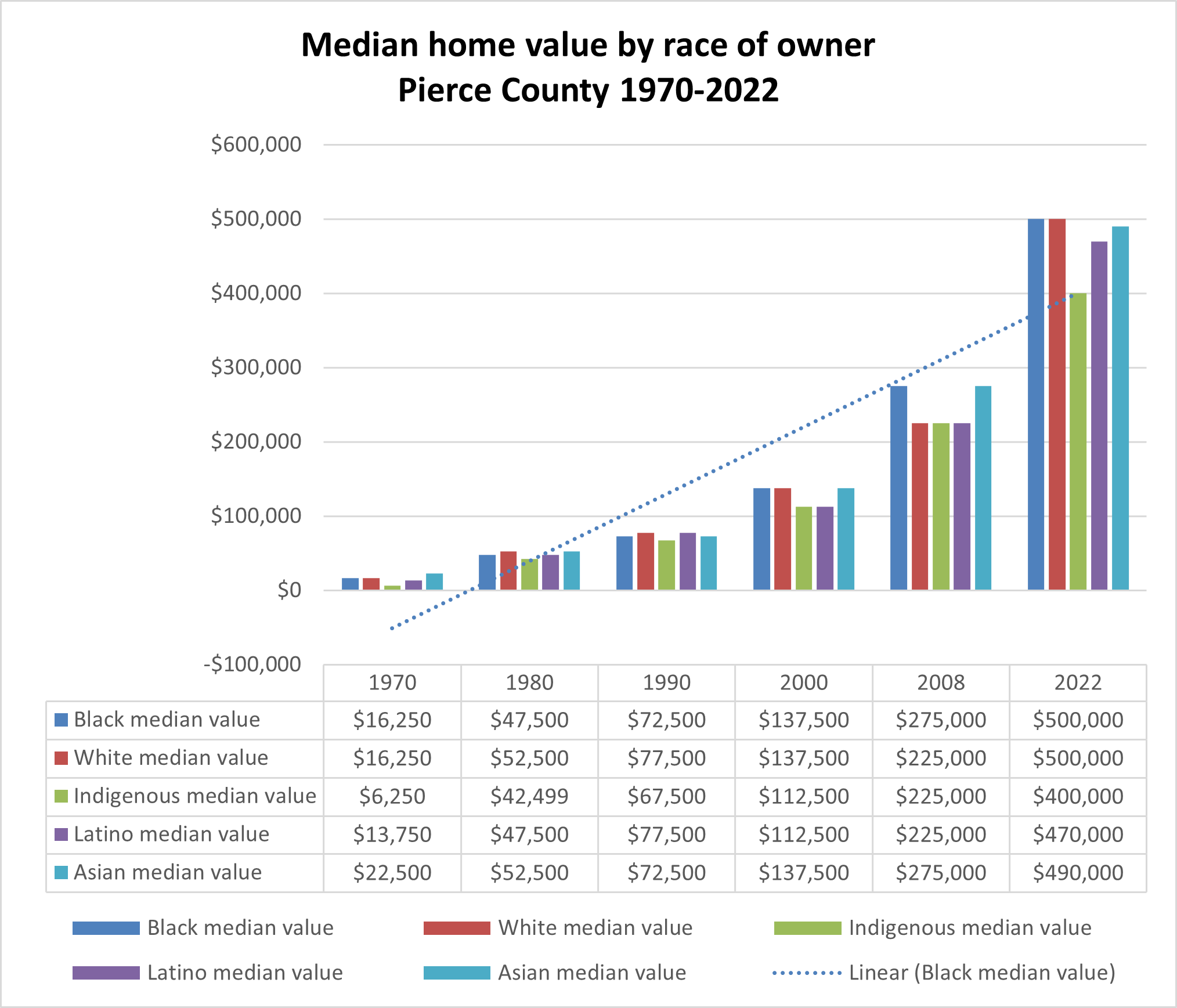Home ownership in Pierce County has followed a disturbing pattern in recent decades. While two-thirds of White families are able to own homes, most Black and Latino families do not. And for Black households the trend has gotten worse. In the most recent census reports the disparity is beyond alarming: 70% of White families are homeowners compared to only 38% of Black families. Fifty years ago, in 1970, 50% of Black families owned homes. Since them it has fallen decade after decade. The charts below tell the story

The disparate rate of homeownership is only part of the problem. In many counties, notably Seattle and King County, the homes owned by Black, Indigenous, and Latino families tend to be worth less than those owned by Whites. That is less of an issue in Pierce County. In the 2021-22 census report, the small number of Black families able to purchase a home (38%) owned property whose median value was comparable to White-owned homes. But look at the chart below. Notice the exponential increase in property values since 1970. Think about what that meant for families that had been prevented from owning property. In 2021-22, the median home in Pierce County was valued at more than 30 times as much as in 1970 ($500,000/$16,250 = 3077%). This far exceeded overall inflation and the rate of increase in family incomes (974%). A family selling a full-valued home could take advantage of this rocketing market, exchanging one house for another or dispersing housing assets through inheritance. But a family trying to buy for the first time in the post-covenant-restriction decades (and those selling undervalued homes) needed much higher incomes to buy property.
Since the 1990s, home buying has required different resources than it did in the golden age of mass homeownership after World War II (1946-1970) when Federal Housing Authority (FHA) assistance helped most White families become homeowners. Buyers have needed wealth to get started; wealth in the form of inheritance or high-paying jobs. Highly paid business-class and professional-class migrants from California, New York, and across the Pacific have been able to join this pricey housing market, while those with modest incomes and without family property wealth have lost out.

The enormous disadvantage that Black families face in Pierce County is made clearer when we consider income. At every income level, White families are more likely to own homes than Black families. The chart below shows ownership rates in 2021-2022 census counts. Among families earning $100,000-150,000 annually, 78% of Whites were homeowners compared with 58% of Blacks. The gap grew starker at more modest family income levels. For those earning between $50,000 and $75,000, 58% of Whites were owners compared with only 36% of Blacks. And look at the difference among those earning less than $50,000. White families were three times more likely to be homeowners than Black families. Remarkably, 51% of White families at this modest income level were able to own homes. Here we see the effects of multigeneration wealth building. At current prices new buyers with modest incomes are shut out of homeownership unless they are converting homes long held in the family or other sources of wealth.

Notes:
The most recent years shown here is an average of 2021 and 2022 from annual American Community Surveys (ACS). The 2-year average improves the reliability of these calculations, all of which are based on samples of the full population (2% for 2021-22 and 1970; 5% in other years). Because these are samples, it is unwise to report very small populations. For that reason the Latino, Asian, and Indigenous categories are not reported until 1980 and the category "Other race" is not shown here.
Households as defined by the Census Bureau can include single individuals or a group of roommates as well as actual families. The race of the household follows the self-identified race of the person designated "head of household."
Home valuations are from Census data and these estimates are not the same as assessed or market values. The Census Bureau asks about home values and families answer this question with little guidance.
Homes in these calculations include condos as well as houses and ownership can mean buying with a mortgage or owning outright.
Race categories in these calculations treat Latino as an exclusive category. Thus the labels Black, White, Indigenous, and Asian do not include anyone who indicated Hispanic/Latino heritage. The category Asian, always complicated, includes Pacific Islanders, South Asians, and East Asians. These charts do not include persons who answered with two or more race categories. Only in recent census surveys was this an option.
Sources: These statistics are calculated from weighted samples of U.S. Census data produced by the Minnesota Population Center's IPUMS USA: Steven Ruggles, Sarah Flood, Ronald Goeken, Megan Schouweiler and Matthew Sobek. IPUMS USA: Version 12.0 [dataset]. Minneapolis, MN: IPUMS, 2022. https://doi.org/10.18128/D010.V12.0. The following samples: 1960 5%, 1970 Metro FM1 and F2 (2%), 1980 5% State, 1990 5% State, 2000 5%, 2010 10%, 2021-2022 ACS 2yr (2%).



